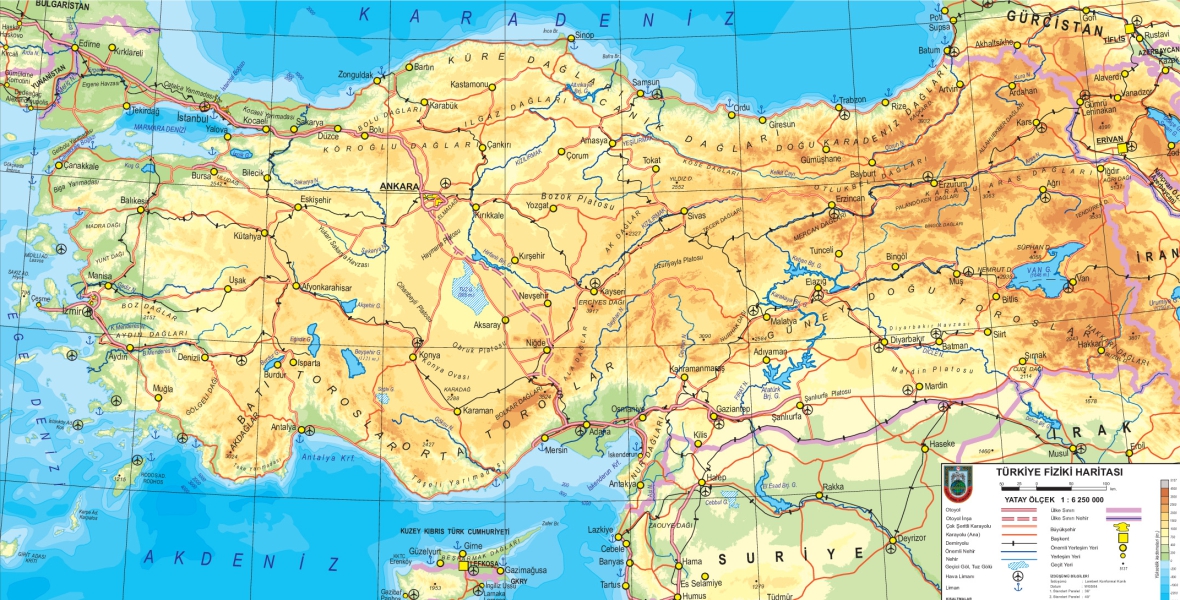
About Turkey Geography
Turkey Geography
Turkey Geography. Because of the location, Turkey is not only a passageway from which the ancient Asian Turkish culture is transmitted to the Europe, but also counted as a window of Western Culture opening to meet the Eastern Culture. Turkey is surrounded by Mediterranean Sea, Black Sea and Aegean Sea brings the country to the neighborhood of the whole world, not only to the neighborhood of the nearby regions. Because of these long coastal borders and being a bridge between the continents of Asia and Europe, Turkey had been the center of the major commerce and immigration roads.
Turkey is located between Europe and Asia continents and displays the view of a rectangle generally. The region with the size of 790 thousand and 200 km2 are located at the Anatolian Peninsula which could be called as Little Asia, and the remaining region with the size of 24 thousand and 378 km2 is located at Thrace, which is located at the east of Balkan peninsula. The total surface area covered is 814 thousand and 578 km2. With its shores, which are at the length of 8 thousand and 272 kilometers, Turkey is a naval country located at the middle of the most ancient main continents of the world.
The First Geography Summit gathered in Ankara at 1941 has separated Turkey into seven major geographic regions after a long and hard study. The first four of this seven pre – determined regions are named by the neighboring seas (Black Sea Region, Marmara Region, Aegean Region and Mediterranean Region). The remaining three regions are named in accordance with their geographic locations inside the total Anatolia (Central Anatolia Region, Eastern Anatolia Region and Southeastern Anatolia Region).
Geography Formations
Turkey is counted as a high country as the mountains cover the majority of the surface, however various plains such as lowlands, plateaus and sediment areas also cover a high ratio. This property diversifies the encountered climate types and also effects the order of the settlements and the economic conditions. Turkey had been separated into seven major geographic regions in accordance with the factors like climate, natural plantation and the distribution of the agricultural activities. These seven major geographic regions are as follows: Mediterranean Region, Aegean Region, Marmara Region, Black Sea Region, Central Anatolia Region, Eastern Anatolia Region and Southeastern Anatolia Region.
As the majority of Turkey is covered with mountains, the major mountain chains present at the northern and southern regions generally draws wide arches, which are parallel to the shore. The mountains at the north are the Northern Anatolia Mountains and the mountains at the south are the Toros (Taurus) Mountains . These mountain chains are separated from each other by the wide plain areas, which are at the central parts of Anatolia. The mountain chains become frequented at the eastern parts of the country and form high altitude peaks. The altitude at the Western part decreases. Mountain chains are uncommon in Aegean and Marmara Regions, this regions mostly display the property of being hollow.
There are wide plains in Southeastern Anatolia, as displayed in the central parts of the country, because this region is far from the reach of the expansions of the Toros (Taurus) Mountain chain. The highest mountain of Turkey is Great Ağrı Mountain (5137 meters) and Süphan Mountain which is an extinct volcano is located inside the borders of Eastern Anatolia Region. Karacadağ, Raman and Sof Mountains are the major mountains of Southeastern Anatolian Region.
There are numerous rivers in Turkey. The majority of the rivers are used in the energy production processes. Fırat and Dicle rivers flowing in Eastern Anatolia reaches and joins with the Basra Gulf, Yeşilırmak, Kızılrmak and Sakarya rivers flowing in Central Anatolia reaches and joins with Black Sea, Susurluk Creek in west and Biga and Gönen creeks reach and join with Marmara Sea; Gediz, Big and Small Menderes rivers reaches and joins with Aegean Sea.
The total surface area of the lakes in Turkey reaches up to 9200 km2 . Eastern Anatolia Region is the richest region of Turkey when the number of lakes are taken into consideration. The biggest lake of Turkey, Van Lake (3713 km2) and Erçek, Çıldır and Hazar lakes are located inside this region. The biggest lakes of Central Anatolia Region are mostly shallow and contain salt in high amounts. The second biggest lake of the country, Tuzgölü (Salt lake) (1500 km2) and Akþehir and Eber lakes are inside the borders of this region. The ferry transportation is executed on Van lake.
Marmara and the Straits are the most important water passages connecting Black Sea to the outer world. Marmara Sea, which is located totally inside the national borders is connected to the Black Sea by Istanbul Bosphorus and is connected to Aegean Sea and Mediterranean by Çanakkale Strait. The Aegean and Western Mediterranean shores of Turkey are generally intended and there are numerous gulfs on these shores.
